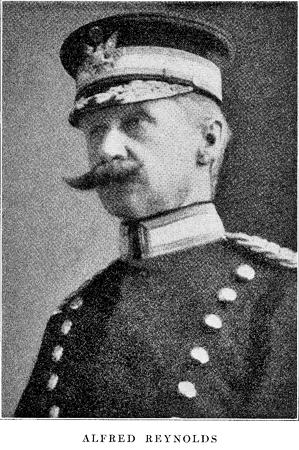

Alfred Reynolds
Commander 22nd Infantry
February 17, 1906 - March 1, 1912
Alfred Reynolds entered the US
Military Academy on September 1, 1870 and graduated
on June 17, 1874 when he was commissioned a 2nd Lieutenant in the
20th Infantry. He graduated
28 out of a class of 41. His best subjects were Tactics and
Drawing and his worst subjects
were Spanish and French. Graduating below him in the same class
was Marion P. Maus
who would become a Lieutenant Colonel in the 22nd Infantry in the
years 1902-1904.
Reynolds served on frontier duty
with the 20th Infantry at Fort Snelling, Minnesota from
September 30 to October 7, 1874. He changed duty station to Fort
Totten, Dakota Territory
on October 12, 1874. He was on a leave of absence from September
22 to October 32, 1875 and
again from June 25 to August 3, 1876. On December 21, 1877 he
left Fort Totten and went
with the Regiment to Texas.
He began duty station with
Company K at Fort Clark, Texas on January 29, 1878. On June 1,
1880
he was promoted to 1st Lieutenant. He served at Fort McIntosh,
Texas from October 5, 1880 to
January 1, 1881, then took a leave of absence until February 1,
1881. In 1881 he was assigned to Company H.
From February 1 to November 5, 1881 he was at Fort Ringgold,
Texas, then went to Fort Leavenworth, Kansas.
In 1884 Reynolds was assigned to
Company A, in which he would remain for the next seven years.
On May 20, 1885 he went to Fort Assinniboine, Montana where he
served until June 1, 1888, when
he went to Fort Maginnis, Montana. From October 15, 1889 to
October, 1890 he was on general
recruiting service at Columbus, Ohio. He rejoined his Regiment in
October 1890 at Fort Assinniboine,
Montana and became the Regimental Adjutant.
Reynolds was promoted to Captain
on February 24, 1891. He was on duty with the Regiment in the
Department of Dakota until October 1894 when the 20th Infantry
changed station to Fort Leavenworth,
Kansas. In April, 1898 the Regiment prepared for deployment to
Cuba by joining with the 4th Army Corps
at Mobile, Alabama. From June 1 to July, 1898 the Regiment was
assigned to Bates' Independent Brigade,
5th Corps and in July it became part of 3rd Division, 5th Corps.
Reynolds commanded Company A
20th Infantry throughout the Santiago de Cuba campaign. In August
1898 he was with the Regiment on quarantine
at Camp Wikoff, Montauk Point, New York. Once released from
quarantine he was on sick leave until
October 1, 1898.
On October 1, 1898 Reynolds
joined his Regiment at Fort Leavenworth, Kansas in prepartion for
deployment
to the Philippines. In January 1899 the 20th Infantry went to San
Francisco and then to the Philippines, arriving
there in February. After participating in several engagments
against Filipino insurgents Reynolds went on duty in
Manila with the provost-guard until November 26, 1899.
While with the provost-guard
Reynolds was promoted to Major of the 22nd Infantry on September
20, 1899.
He joined the 22nd Infantry Regiment on December 7, 1899 at
Candaba, Luzon and was given command of
2nd Battalion at Arayat, Luzon until March 16, 1900. From March
17 to September 20, 1900 he commanded
the Military Prison at San Isidro, Luzon.
Reynolds was transferred back to
the 20th Infantry on September 20, 1900. On February 28, 1901 he
was
detailed to the Inspector-General's Department and served in that
capacity until promoted to Lieutenant Colonel
of the 11th Infantry on February 23, 1903. He served in the 2nd
Infantry from April 6 to May 18, 1903,
then from that date to July 27,1903 he was with the 10th
Infantry.
On July 27, 1903 he transferred
back to the 20th Infantry where he was again detailed as
Inspector-General on March 29, 1904.
Reynolds was promoted to Colonel
of the 22nd Infantry on February 17, 1906. He joined the Regiment
at Fort McDowell, California on April 10, 1906. He was on duty in
San Francisco during and subsequent to
the earthquake and fire April 18 to May 3, 1906, during the
manueuvers at American Lake, Washington
July 12 to September 19, 1906 and at Goldfield, Nevada during the
labor troubles December 7, 1907
to January 3, 1908.
He took the 22nd Infantry to
Alaska from 1908 to 1910 and in 1910 brought the Regiment to
Texas for
Mexican Border duties. He commanded the Regiment during the
Army's Maneuver Division experiment in 1911.
He was at Fort Sam Houston, Texas until March 1, 1912 in command
of the 22nd Infantry when, at his own
request he was retired from the Army after 43 years of military
service.
He was recalled to active duty
during the First World War and detailed as Professor of Military
Science and
Tactics at Pennsylvania Military College at Chester, Pennsylvania
from October 22, 1917 to September 11, 1918.
He was a member of the Society of the Army of Santiago de Cuba.
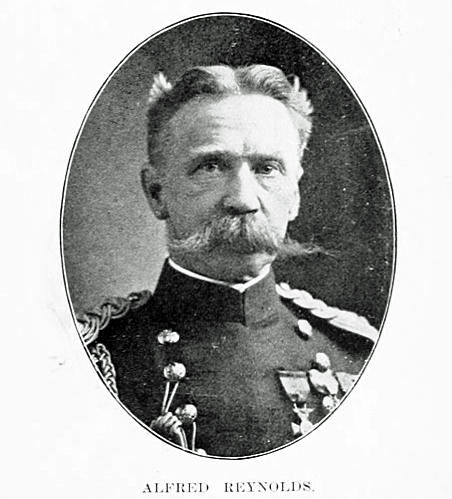
Colonel Alfred Reynolds
A version of this portrait of Colonel
Reynolds hung on the wall at 1st Battalion 22nd Infantry
Headquarters
at Fort Hood, Texas, 1999-2009.
Original photo From "A military album,
containing over one thousand portraits of commissioned officers
who served in the Spanish-American war" L.R. Hamersly 1902.
The following biography of Alfred Reynolds is from the Find A Grave website:
Birth: Mar. 2,
1849
Pennsylvania, USA
Death: Dec. 11, 1925
San Francisco
San Francisco County
California, USA
United States Army Officer. A native of Pennsylvania, Reynolds
graduated from the United States Military Academy
at West Point in 1874. A veteran of both the Spanish American War
and Philippine Insurrection, he rose up through the ranks
to be eventually promoted to the rank of Colonel and assigned to
the 22nd Infantry Regiment in February 1906, which he joined
at their post at Fort McDowell on Angel Island in the San
Francisco Bay on April 10, 1906. Eight days later, San Francisco
was shaken by a major earthquake that resulted in massive fires
breaking out all around the city. With the fires out of control,
Brig. General Frederick Funston, acting commander at the San
Francisco Presidio, took control of the situation and ordered
Col. Reynolds to take the 22nd Infantry into the city to help in
the firefighting efforts and relief. In December 1907, Reynolds
and the 22nd Infantry were again called out, this time to go to
Goldfield, Nevada to help keep the peace during an organized
mining strike and would remain there until January 1908. He
retired at the rank of Colonel in 1912.
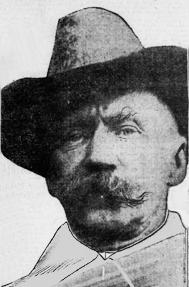
Colonel Alfred Reynolds wearing his pre-1910 campaign hat
Photo from the San
Francisco Call newspaper December 7, 1907,
in an article about Colonel Reynolds taking the 22nd Infantry to
Goldfield, Nevada, on December 6, 1907.
CDNC California Digital Newspaper Collection
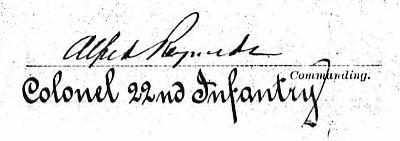
The signature of Alfred Reynolds as
Commanding Officer of the 22nd Infantry
on the monthly Return of the 22nd Infantry for August 1906.
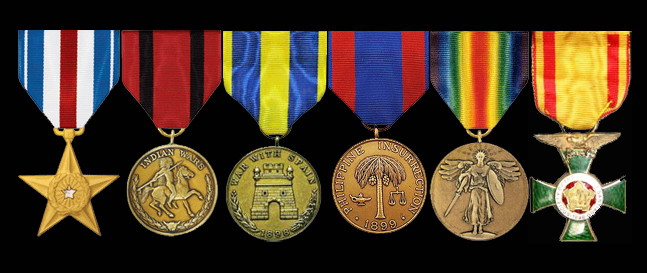
Colonel Alfred Reynolds' decorations
ALFRED REYNOLDS
NO. 2536 -----CLASS OF 1874
Died December 11, 1925, at the Letterman General Hospital,
aged 76 years.
ALFRED REYNOLDS was born in
Philadelphia, Pennsylvania, March 2, 1849. He was educated in the
public schools
of that city and his fondness for the military service was
exemplified by his enlistment as a private in Company
"C,"
1st Regiment of Infantry, 2nd Brigade, 1st Division of the
National Guard of Pennsylvania on October 1, 1869,
from which he was discharged to accept an appointment to West
Point tendered to him by the Honorable Secretary of War
in 1870. He entered West Point September 1, 1870, and graduated
therefrom on June 17, 1874. Assigned to and joined
the 20th U. S. Infantry September 1, 1874, at Fort Snelling,
Minn. At the end of that month he was assigned to a company at
Fort Totten, Devil's Lake, Dakota, where he served till December,
1877. Continuing with his regiment when it was transferred
to Texas at that time he served at Forts Brown, Ringgold,
Mclntosh and Clarke until 1881 when he was ordered to
Fort Leavenworth, Kansas, as Quartermaster of the school to be
established there, serving at that post till 1885. From 1885
to 1894 he was with his regiment in Montana. Regimental Adjutant
in 1890 and promoted to rank of Captain on
February 24, 1891. Returning to Fort Leavenworth with regiment in
1894 he served at that post till the outbreak of the
War with Spain. In Cuba with regiment during the war and in
engagements at El Caney and around Santiago,—thence to
the United States and to the Philippines in February, 1899. After
participating in several affairs with the insurgent Filipinos
was on duty in Manila with Provost-guard to November 26, 1899.
(Major of Infantry, 22nd
Infantry, Sept. 20, 1899.) Joined regiment at Candaba, Luzon, P.
I., December 7, 1899;
commanding 2nd Battalion at Arayat, Luzon to March 16, 1900;
commanding Military Prison, San Isidro, Luzon,
from March 17, 1900. Transferred to 20th Infantry Sept. 20, 1900;
Inspector-General by detail Feb. 28, 1901.
(Lieutenant Colonel of Infantry,
11th Infantry, Feb. 23, 1903). Transferred to 2d Infantry, April
2, 1903; transferred to
10th Infantry May 18, 1903; transferred to 20th Infantry July 27,
1903; Inspector-General by detail March 29, 1904.
(Colonel of Infantry, 22nd
Infantry, Feb. 17, 1906). Joined regiment at Fort McDowell,
Calif., April 10, 1906.
This regiment was one of the first organizations to arrive and
start relief work during the fire of April, 1906. On duty
in that city till May 3, 1906; during the maneuvers at American
Lake, Washington, July 12th to Sept. 19, 1906. At Goldfields,
Nevada, during the labor troubles Dec. 6, 1907 to Jan. 3, 1908.
With regiment in Alaska 1908-1910 and at Fort Sam Houston,
Texas, until March 1, 1912, when he was retired at his own
request after more than 41 years service.
Returned to active duty Sept.
11, 1917; detailed as Professor of Military Science and Tactics
at the Pennsylvania Military College
at Chester, Pa., until Sept. 11, 1918, when he was relieved and
on same date was recalled to active duty and assigned to command
of Student Army Training Unit at Pennsylvania Military College,
Chester, Pa., and Swarthmore College, Swarthmore, Pa.
In November he was ordered to duty at Princeton University,
Princeton, N. J., and then to Stevens Institute of Technology,
Hoboken, N. J., as Commanding Officer and acting Quartermaster of
the Student Army Training Camp unit thereat.
At the end of the World War Colonel Reynolds returned to San
Francisco, Calif., where he had made his home previous
to the World War. He died in that city on Dec. 11, 1925, and was
buried in the National cemetery at the Presidio of San Francisco,
Calif., on Dec. 14, 1925.
He was awarded the Silver Star,
the citation reading "For gallantry in action against the
Spanish Forces at El Caney, Cuba,
July 1, 1898." Though the above was not received by his
widow' till May, 1927, Colonel Reynolds had been informed
of the intended testimonial some months previous to his death and
had the pleasure of knowing there would be issued
at a future date the above expression of appreciation of his
services.
That his sterling qualities as
an officer had been recognized at an early date is evidenced by a
letter written by General Custer,
May 13, 1876, about six weeks before the Custer Massacre in which
the General says: "I regret exceedingly that you could not
have been spared from your post this summer as I made special
application for you on my arrival in St. Paul in February.
The Department Commander hesitated in granting my application on
account of your duties as Adjutant. Otherwise you would
have been ordered to accompany the expedition."
A glimpse of his kindly
disposition, an understanding of his deep interest in the
enlisted men and a realization of his standard
for officers may be obtained from some of the orders issued by
him as regimental commander. He directed the
company commanders "to instruct and regulate the
noncommissioned officers with tact and judgment so as to insure
the execution of orders without partiality or harshness,"
and to the officers he said, "The force of example is very
great,
so that the enlisted men of an organization comport themselves
much as do their officers; therefore it is enjoined upon all
officers to be exact in their apparel and personal appearance,
and in deportment to be dignified and military."
Colonel Reynolds was the son of
John Reynolds and Elizabeth Trimble Gardner. The father was born
in Ireland and was
a Major of Volunteers during the Civil War. In Camden, N. J.,
where he resided at the outbreak of the Civil War he raised
the first company of volunteers recruited in that city. On June
22, 1879, at Fort Brown, Texas, Colonel Reynolds married
Adelaid E. Eckerson, daughter of Major Eckerson, Q. M. Dept., U.
S. Army. Two children were born of that marriage,
a son who died in infancy and a daughter, Elizabeth G. Reynolds,
born in 1880, who served overseas during the World War
as a Red Cross nurse in Paris and who died in 1922. Mrs. Reynolds
died in 1910. In 1918 Colonel Reynolds married the
widow of Major John H. Wholley, U. S. Army, who survives him and
resides in San Francisco, Calif.
Shortly after his return to San
Francisco after the World War Colonel Reynolds became Secretary
of the Presidio Golf Club
and the following is taken from the minutes of that Club:
"On Friday, December 25,
1925, at the Letterman General Hospital in the Presidio, our
beloved Secretary,
Colonel Alfred Reynolds, passed away quietly, gently and
peacefully. .... In response to the general demand that there be
more than a mere passing notice of the Colonel's going there was
a gathering of men and women, members of this Club
and of the United Service Golf Club, on the afternoon of Sunday,
December 27th, at the Club House, to do honor to his memory
.... we .... Resolve that in the passing of Colonel Reynolds, our
faithful, loyal Secretary for more than five years,
this Club has sustained a loss which cannot be repaired; that his
performance of the duties of Secretary of the Club
was of the highest order; that his fund of close and accurate
information concerning all of the Club's affairs, its customs,
precedents and practices, was invaluable and was ever at the
ready service of the Council at its meetings, which he
punctiliously attended; that his amiable demeanor, coupled with
his ever smiling, cheerful, buoyant presence, was an
inspiring example to all who had the rare privilege of enjoying
close contact with him; that in his excellent performance
of the duties also of Secretary of the United Service Golf Club
he tactfully and gracefully united the activities of both Clubs
to the joint advantage, enjoyment and satisfaction of their
members; that we deeply mourn his going and extend our most
profound, tender and sincere sympathy to his family."
On the day of the Colonel's death a caddy wrote the following:
Seems but yesterday, club in
hand
He played his shots, fairway or sand;
And alike to dub or pro
His smile and words more kindly, so
We who knew him in work or play,
Can but stand and silent pray
And ask of Him, who keeps the score
To raise his handicap a wee bit more.
A Friend ¹
Burial:
San Francisco National Cemetery
San Francisco
San Francisco County
California, USA
Plot: OS, 3-A PL 4
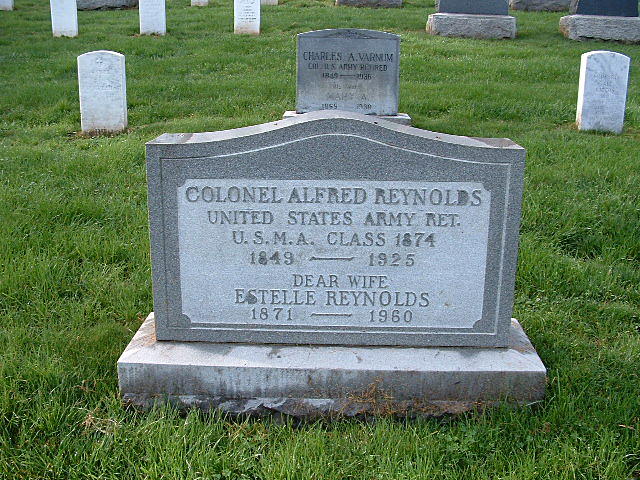
The grave monument for Alfred Reynolds
Photo by G.Photographer from the Find A Grave website
¹ SIXTY-SECOND ANNUAL REPORT of the
Association of Graduates of the United States Military Academy
at West Point, New York, June 10, 1931 : The Lakeside Press R.R.
Donnelley & Sons Company
Crawfordsville, Indiana
Home | Photos | Battles & History | Current |
Rosters & Reports | Medal of Honor | Killed
in Action |
Personnel Locator | Commanders | Station
List | Campaigns |
Honors | Insignia & Memorabilia | 4-42
Artillery | Taps |
What's New | Editorial | Links |